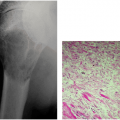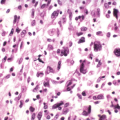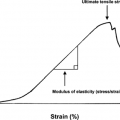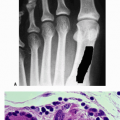Evaluation of Bone Tumors
Timothy A. Damron
Bone lesions can be difficult to identify specifically, and arriving at a specific diagnosis can elude even the most experienced orthopaedic oncologist. However, by using a systematic approach to the evaluation of these tumors, including consideration of the pathogenesis, often a narrow enough differential diagnosis may be arrived at by clinical and radiological means to allow specific treatment (often observation) or to guide the subsequent evaluation and care. This chapter discusses pathogenesis and an approach to evaluation of bone tumors.
Pathogenesis
Etiology
The vast majority of bone tumors arise de novo with no identifiable predisposing precursor lesion or associated agent. However, well-defined clinical precursor lesions have been established (Box 1-1).
Established etiologic agents for osteosarcoma are given in Box 1-2.
Implicated but unproven causes:
Chromium, nickel, cobalt, aluminum, titanium, methyl-methacrylate, polyethylene
Trauma
Epidemiology
Incidence of bone sarcomas
0.2% of all cancers
0.8 new cases per 100,000 population per year in North America and Europe
Most common bone sarcomas
#1: Osteosarcoma
#2: Chondrosarcoma
#3: Ewing sarcoma
Age distribution is bimodal
First peak: Second decade of life
Osteosarcoma predominates at this age
Ewing sarcoma #2
Second peak: >mt60 years old
Chondrosarcoma predominates
Secondary osteosarcomas #2
Paget’s osteosarcoma
Postradiation osteosarcoma
Pathophysiology
Unknown for most bone tumors
Best described for congenital and inherited syndromes (Table 1-1)
Classification
Current classification systems are derived from the type of cell or tissue involved. Hence, bone tumors are divided into osseous, cartilaginous, cystic, myogenic, lipogenic, epithelial, neural, notochordal, fibrous, fibrohistiocytic, giant cell, round cell, and vascular categories as well as those of undefined neoplastic nature. The organization of the subsequent chapters follows this classification scheme.
Box 1-1 Precursor Lesions for Development of Bone Sarcoma
Low Risk
Fibrous dysplasia
Bone infarct
Chronic osteomyelitis
Metallic and polyethylene implants
Osteogenesis imperfecta
Giant cell tumor
Osteoblastoma
Chondroblastoma
Intermediate Risk
Multiple osteochondromas
Polyostotic Paget disease
Radiation osteitis
High Risk
Ollier’s disease (enchondromatosis)
Maffucci syndrome
Familial retinoblastoma syndrome
Rothmund-Thompson syndrome
Adapted from
Fletcher DM, Unni KK, Merlens F, eds. Tumours of Soft Tissue and Bone. World Health Organization Classification of Tumours. Lyon: IARC Press, 2002:228
.Diagnosis
For bone lesions, one of the primary goals of the history, physical examination, and radiological evaluation is to at least classify the lesion into one of three categories of biological behavior: latent, active, or aggressive (Table 1-2). The last category includes both aggressive benign lesions and malignancies. In some cases, a specific diagnosis may be attainable, but if not, this classification provides some guide to the need for diagnostic evaluation and treatment.
History and Physical Examination
The patient with a bone lesion in general presents in one of four clinical scenarios: (1) incidentally noted bone lesions, (2) painless bony masses, (3) painful bone lesions, and (4) pathologic fractures. The differential diagnosis and approach are guided by which of these scenarios applies. Hence, the clinical features are divided into those four categories.
Box 1-2 Etiologic Agents in the Development of Osteosarcoma
Chemical Agents
Methylcholanthrene
Beryllium oxide
Zinc beryllium silicate
Radiation
Radium dye workers
Thorotrast radioactive contrast medium
Therapeutic radiotherapy
Viruses
Rous sarcoma virus (v-Src gene)
FBJ virus (c-Fos gene)
Incidentally Noted Bone Lesions
This very frequent scenario in musculoskeletal tumors occurs commonly in a number of ways, such as when a minor injury leads to an x-ray that reveals a bone lesion, shoulder pain from impingement leads to discovery of a proximal humeral bone lesion, or a bone scan done for an entirely different purpose lights up unexpectedly at the site of a previously unrecognized bone lesion not associated with the original problem.
Differential Diagnosis
Common bone lesions discovered incidentally
Adults: enchondroma
Pediatrics: nonossifying fibroma
History
Injury leading to discovery
Did pain precede the injury? Pain preceding the injury may indicate an active or aggressive lesion rather than the typical latent lesion discovered incidentally.
Is pain resolving since injury? Complete resolution of the injury-related pain supports the incidental nature of the bone lesion.
Pain leading to discovery. The key is to determine whether the pain is more likely to be from a common cause of pain at the affected anatomic site or from the bone lesion itself.
Shoulder: Elicit exacerbating features such as overhead activity as an indicator of impingement. Consider subacromial injection.
Knee: Elicit exacerbating features such as going up and down stairs and sitting for long periods with knees flexed as indications of patellar-femoral discomfort. Consider intra-articular injection.
Bone scan leading to discovery
Has there ever been pain or local tenderness at the site of the bone lesion? Some patients may have had a mild aching pain at the site of a low-grade malignancy that they never sought medical attention for in the past.
Physical Examination
Bone tenderness (tumor) versus joint line tenderness (intra-articular pathology) is an important distinguishing feature.
Signs of the possible joint problem causing pain (if any) should be elicited.
Diagnostic Workup
Blood work: No role unless infection suspected (obtain complete blood count >obCBC>cb with differential, erythrocyte sedimentation rate >obESR>cb, C-reactive protein >obCRP>cb)
If suspected cartilage neoplasm, consider computed tomography (CT) or magnetic resonance imaging (MRI)
CT scan: Delineates endosteal scalloping, periosteal reaction best
Table 1.1 Congenital And Inherited Syndromes Predisposing to Bone Sarcomas
Syndrome
Inheritance Pattern
Typical Tumors/Findings
Malignancy
Implicated Genes
Pathophysiology
Ollier’s disease and Maffucci syndrome
Mostly sporadic
Some families suggest AD
Multiple enchondromas (hemangiomas in Maffucci syndrome)
Chondro-sarcoma in Ollier’s disease; multiple malignancies in Maffucci syndrome
Unknown
Unknown
McCune-Albright syndrome (MAS), polyostotic fibrous dysplasia, monostotic fibrous dysplasia
Sporadic
Multiple lesions of fibrous dysplasia (endocrine abnormalities and coast of Maine pigmented skin lesions with MAS)
GNAS1 (guanine nucleotide-binding protein, α-stimulating activity polypeptide 1)
Extent of disease dependent upon how large of a cell mass is affected by somatic mutation during embryogenesis
Multiple osteochondromas
50% sporadic
50% AD
Osteochondromas
Chondrosarcoma
EXT1, EXT2 (exostosin)
Mutant exostosin glycoproteins alter heparin sulfate proteoglycans, affecting FGF and Ihh signaling
Retinoblastoma syndrome
60% sporadic
40% AD
Retinoblastoma
Osteosarcoma
Other cancers
RB1
Mutant RB1 tumor suppressor gene allows tumor development
Rothmund-Thomson syndrome
AR
Poikiloderma
Short stature
Sparseness of eyebrows/lashes
Juvenile cataracts
Sunlight sensitivity
Hypogonadism
Defective dentition
Nail problems
Osteosarcoma
Cutaneous epitheliomas
Gastric adenocarcinomas
Fibrosarcomas
RECQL4
Mutant helicase gene
Bloom syndrome
Telangiectatic erythema resembling SLE
Dwarfism
Thin, triangular face
Osteosarcoma
Other cancers
BME
Mutant RECQ helicase gene
Li-Fraumeni syndrome
<45 with sarcoma and first-degree relative <45 with any cancer and another first- or second-degree relative in same lineage with any cancer at any age
Osteosarcoma
Soft tissue sarcoma
Breast cancer
Brain tumors
Acute leukemia
Adrenal cortical cancers
Gonadal giant cell tumors
TP53 gene (71%)
Mutant p53 tumor suppressor gene
Table 1-2 Classification of Bone Tumors According to Biological Behavior
Classification
Symptoms
Type of Bone Lesion
Radiographic Features
Common Examples
Latent
Asymptomatic
No pain preceding fracture
Benign
Narrow zone of transition
Nonossifying fibroma* (fibrous cortical defect)
Unicameral bone cyst*
Adult osteochondroma*
Active
Painful
Pain preceding fracture
Benign
Intermediate zone of transition
Expansion
Fibrous dysplasia
Osteoid osteoma
Osteochondroma
Aggressive or malignant
Painful
Pain preceding fracture
Benign or malignant
Broad zone of transition
Cortical destruction
Soft tissue extension
Benign
Aneurysmal bone cyst#
Chondroblastoma#
Giant cell tumor#
Osteoblastoma#
Malignant
Sarcoma
Metastatic carcinoma
Lymphoma
*Classic latent lesions such as these may be active during childhood.
#Some tumors, such as aneurysmal bone cyst, chondroblastoma, and giant cell tumor, may have a spectrum of clinical behavior patterns.
MRI scan: Helps differentiate features of hyaline cartilage
Lobular organization pattern, bright with T2 weighting, dark with T1 weighting
If fibrous dysplasia or enchondroma considered, consider total body bone scan to establish solitary or polyostotic process
Enchondroma versus Ollier’s disease/enchondromatosis
Monostotic versus polyostotic fibrous dysplasia or McCune-Albright syndrome
If presumptive diagnosis of latent lesion is established on plain radiographs, key is serial clinical and radiographic follow-up.
Common serial follow-up plan: 3 months, 6 months, 1 year, and 2 years after discovery
If lesion behaves more aggressively than expected, biopsy and appropriate surgical treatment may be necessary.
In most cases, the lesion will remain unchanged (e.g., enchondroma) or go on to heal (e.g., nonossifying fibroma), and after 2 years of follow-up, most asymptomatic lesions may be considered stable.
Biopsy is usually unnecessary.
Painless Bony Masses
Differential Diagnosis
Osteochondroma (most common by far)
Low-grade malignancies with associated soft tissue mass
Parosteal osteosarcoma
Periosteal chondrosarcoma
Secondary chondrosarcoma arising in osteochondroma
History
Age
Pediatric patient: Osteochondroma grows during skeletal immaturity
Adult patients: Osteochondromas should not grow once growth has ceased. Consider other diagnoses.
Pain
Osteochondroma typically painless unless pressure on other structures
Pain may be associated with low-grade malignancies.
Family history of osteochondromatosis
Half of cases are spontaneous mutations, so many patients will have negative family history despite autosomal-dominant (AD) mode of transmission.
Physical Examination
Bone versus soft tissue origin
Soft tissue masses close to bone may mimic surface bone lesions (myositis ossificans).
Signs of multiple osteochondromatosis
Other bony masses
Short stature
Findings that might warrant surgical excision of osteochondroma
Local tenderness, limited motion, nerve compression
Diagnostic Workup
Blood work: No role unless infection suspected (obtain CBC with differential, ESR, CRP)
Total body bone scan: establish monostotic versus polyostotic process
Solitary osteochondroma versus osteochondromatosis
If distinction between benign and malignant lesions necessary, consider CT scan.
Myositis ossificans shows peripherally mature mineralization.
Osteochondroma shows continuity of cortical and medullary bone from stalk to adjacent bone.
Parosteal osteosarcoma gives a “stuck-on” appearance, often with a very thin radiolucency between the lesion and the underlying bone.
If osteochondroma or parosteal osteosarcoma suspected, MRI scan should be obtained.
For osteochondroma: assess thickness of cartilage cap, especially in adults, to differentiate from peripheral chondrosarcoma.
Cap thickness >mt2 cm is consistent with a chondrosarcoma.
Cap thickness 1 to 2 cm in adults is concerning for chondrosarcoma.
For parosteal osteosarcoma, MRI determines both soft tissue extent and involvement of underlying medullary cavity.
If parosteal osteosarcoma is a diagnostic consideration or if the diagnosis cannot be established with imaging studies, a biopsy is needed.
Painful Bone Lesions
Differential Diagnosis
Pediatric patients (<20)
Painful active lesions
Osteoid osteoma
Painful aggressive benign lesions
Osteoblastoma
Aneurysmal bone cyst
Langerhans cell histiocytosis
Painful malignant lesions
Osteosarcoma
Ewing sarcoma
Young adult patients (20 to 40)
Giant cell tumor of bone
Lymphoma
Ewing sarcoma (5 to 30 years)
Adult patients (>mt40)
Metastatic carcinoma
Myeloma
Lymphoma
Chondrosarcoma and other sarcomas
History
If osteoid osteoma suggested, seek typical pain pattern (worse at night, relieved by nonsteroidal anti-inflammatory agents >obNSAIDs>cb).
Pain at rest in addition to mechanical pain suggests tumor-related pain.
Tumor-related causes of rest pain
Bone destruction
Intraosseous pressure
Proteinases
Inflammatory cytokine response
Tumor-related causes of activity-related pain
Advanced bone destruction
Extra-osseous soft tissue pressure
If malignancy suspected, check for systemic symptoms, more common with disseminated malignancies.
Fevers, chills, unintentional weight loss, anorexia, fatigue
In adults, elicit risk factors for and signs of systemic malignancies:
Family history of breast cancer
Prostate symptoms for prostate cancer
Smoking history for lung cancer
Hematuria for renal cancer
Thyroid masses/symptoms for thyroid cancer
Complete review of systems
Physical Examination
Adults (also see section on metastatic disease)
Potential sources of primary carcinoma (especially breast, prostate, lung, kidney, thyroid)
Other evidence of metastatic disease (lymph nodes, soft tissues)
All: Site of primary symptoms
Diagnostic Workup
Blood work
Pediatrics: Infection is always a consideration, so CBC with differential, ESR, and CRP are needed.
Adults (also see Chapter 8, Metastatic Disease)
CBC, ESR, serum calcium and phosphorus, alkaline phosphatase, lactate dehydrogenase, serum protein electrophoresis, prostate-specific antigen, urinalysis
Bone scan
Assesses for multifocal disease in potentially polyostotic pediatric processes and in metastatic or multifocal adult tumors
Identifies potential sites of referred pain
Stay updated, free articles. Join our Telegram channel

Full access? Get Clinical Tree








